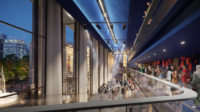North Bennington, Vermont
Of the three new buildings that compose Tod Williams and Billie Tsien’s Center for the Advancement of Public Action (CAPA) at Bennington College in Vermont, it is the program-less “Lens” that best represents the iconoclastic institution where students have been designing their own curricula since 1932. The Lens is somewhat of a folly: Black walnut benches define the interior space of a marble-clad cube and cerulean walls slope inward and up to a James Turrell–like manual oculus. The space is open from morning to night, with the idea that solutions for the world’s ills—CAPA’s purpose—don’t always begin with collaboration.
CAPA’s other two marble buildings house a lush, luxe residence for visiting scholars, and a symposium with classrooms, offices, the college’s first-ever faculty lounge, and a mini-UN-style seminar room. The idea for CAPA coalesced during several years of discussion about a new academic program that would engage students in urgent social issues. It was given a jump-start in 2007 by a $20 million gift from Susan Paris Borden (class of 1969) and her husband, Robert. “One of the reasons CAPA emerged was the challenge of the world,” says Elizabeth Coleman, Bennington’s president since 1987. “How do you, as an educational institution, sit still in the face of what’s going on? How do you just act as if nothing is going on? To me, that’s no longer acceptable.”
CAPA opened last fall, offering classes in technology and social change, the politics of the AIDS pandemic, and “Solving the Impossible.” It houses offices for a seven-week fieldwork term. Yet its program remained undefined well into the architects’ design planning. This led to frustrating and costly redesigns, but the overall experience was deeply satisfying for the team. “It was an opportunity to work on something where we really believed in the mission,” says Tsien.
Tsien and Williams sited CAPA behind a performing and visual arts building, in front of a pond and a meadow leading up to the very back of the campus and one of the college’s oldest building, Jennings Hall, a 1903 Colonial Revival mansion made of Vermont granite. This led to a cleanup of the pond, and better connected the campus to Jennings.
The low, skewed buildings sit in a semicircular cluster and are clad in reclaimed Vermont marble slabs, set unevenly in the facade to show off their weathered imperfections. The architects rented a warehouse nearby to lay out each slab precisely. CAPA sits on a slight rise, and the cornices of each building are the same height. While the marble sets CAPA apart from other buildings on campus by architects such as Kyu Sung Woo and Pietro Belluschi, it fits into the context.
“We wanted it to be somewhat like walls in the landscape and not have such a big presence,” says Tsien. “Rather than compete with the power of the landscape, we wanted to draw power from being lower, tighter, smaller, denser.” Williams explains further: “We also have a strong belief that the surface of the campus is where the real dialogue occurs. Community exists on the ground. What we were trying to do is charge the ground.”
The quiet richness exhibited by CAPA’s exteriors also imbues its interiors. The walnut used for the benches in the Lens is a repeating material in the other two buildings, with custom-made cabinetry and batten walls.
The spa-like apartments have Japanese soaking tubs, handmade tiles, and views of the pond and meadow. “That’s very intentional,” says Coleman. “We want [visiting fellows and scholars] who come here to want to come back and to feel special.”
Classrooms, by contrast, are muted and flexible, ready for courses that have not yet been dreamed up. A central courtyard lined with frosted glass allows natural light to flood the corridors and common spaces. “In the academy, we treat our work as separate from, and even corrupted by, action,” says Coleman. CAPA affirms the opposite—that action isn’t an indulgence, but a necessity.
Architect
Tod Williams Billie Tsien Architects
222 Central Park South
New York, NY 10019
212-582-2385
Completion Date: July 2011
Gross square footage:
17,861 square feet
Construction cost: $13.6 million
PeopleClient: Bennington College
Architect:
Personnel in architect's firm who should receive special credit:
Susan Son, Project Architect
Project Team Members:
MEP Engineer:
Structural Engineer:
Civil Engineer:
Lighting Designer:
Acoustic, AV, Telecom:
Landscape Architect:
Graphics Consultant:
Roof Hatch Consultant:
Fountain Consultant:
Millwork:
Custom Ceramic Tile:
Custom Fabric Tapestry:
Stone Consultant:
Marble Supplier:
Granite Supplier:
Photographer: |
Products
Structural system
Exterior cladding Moisture barrier: Tremco, Carlisle
Roofing Metal: Revere Copper Freedom Grey Other: Custom designedmanually operated roof hatch: Turner Exhibits
Windows
Glazing
Doors Wood doors: Duratherm Sliding doors: Duratherm
Hardware Closers: Sargent Exit devices: Von Duprin Pulls: Rockwood
Interior finishes Paints and stains: Sherwin-Williams Solid surfacing: Corian Floor and wall tile (cite where used): Restroom wall tiles: Gustin Ceramics Resilient flooring: Duro Design (cork) Special interior finishes unique to this project: Rosco paint, Off-Broadway Felt-Wall Tapestries: Claudy Jongstra
Furnishings
Lighting Downlights: Lucifer, Lightolier Dimming System or other lighting controls: Lutron |




















































































